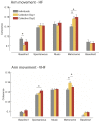Spontaneous group synchronization of movements and respiratory rhythms
- PMID: 25216280
- PMCID: PMC4162643
- DOI: 10.1371/journal.pone.0107538
Spontaneous group synchronization of movements and respiratory rhythms
Abstract
We tested whether pre-assigned arm movements performed in a group setting spontaneously synchronized and whether synchronization extended to heart and respiratory rhythms. We monitored arm movements, respiration and electrocardiogram at rest and during spontaneous, music and metronome-associated arm-swinging. No directions were given on whether or how the arm swinging were to be synchronized between participants or with the external cues. Synchronization within 3 groups of 10 participants studied collectively was compared with pseudo-synchronization of 3 groups of 10 participants that underwent an identical protocol but in an individual setting. Motor synchronization was found to be higher in the collective groups than in the individuals for the metronome-associated condition. On a repetition of the protocol on the following day, motor synchronization in the collective groups extended to the spontaneous, un-cued condition. Breathing was also more synchronized in the collective groups than in the individuals, particularly at rest and in the music-associated condition. Group synchronization occurs without explicit instructions, and involves both movements and respiratory control rhythms.
Conflict of interest statement
Figures





References
-
- Radcliffe-Brown AR (1922) The Andaman Islanders. New York: Free Press.
-
- Demos AP, Chaffin R, Begosh KT, Daniels JR, Marsh KL (2011) Rocking to the Beat: Effects of Music and Partner's Movements on Spontaneous Interpersonal Coordination. J Exp Psychol Gen 141: 49–53. - PubMed
-
- Issartel J, Marin L, Cadopi M (2007) Unintended interpersonal co-ordination: “can we march to the beat of our own drum?”. Neurosci Lett 411: 174–179. - PubMed
Publication types
MeSH terms
LinkOut - more resources
Full Text Sources
Other Literature Sources
Molecular Biology Databases

